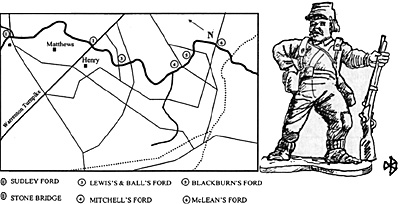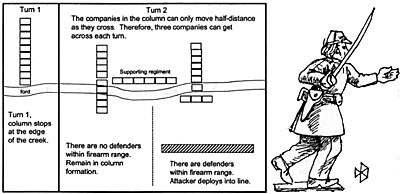 In my game, the wargamer plays the confederates while the federals are automated. The objective of the confederate player is to keep all federal forces on the north side of Bull Run. The confederate player sets up according to the following rules. First, Johnston's troops (one-third of the army) start at the junction of the Manassas Gap and Orange & Alexandria railroads. Second, no confederates can start north of the Warrenton Turnpike.
In my game, the wargamer plays the confederates while the federals are automated. The objective of the confederate player is to keep all federal forces on the north side of Bull Run. The confederate player sets up according to the following rules. First, Johnston's troops (one-third of the army) start at the junction of the Manassas Gap and Orange & Alexandria railroads. Second, no confederates can start north of the Warrenton Turnpike.
The game will be played using whatever rules you are comfortable with. I use a homegrown set that covers movement, firing, melee, and morale. More on rule variants below.
The historical problem for the confederates is that they have a foggy notion of the federal plan. There are no reconnaissance elements north of Bull Run and the creek itself has steep sides well concealed by trees. You don't know the federals are on the river until they are only yards away. Since the federals hit the stream somewhat piecemeal, it was not apparent to the confederates just where the main attack was shaping up. The rules need to create this level of uncertainty.
The rules cover, in order, WHEN the federals arrive at a crossing site, WHERE they arrive, and in what STRENGTH. Here's how I do it. First, roll 1D6 at the beginning of each turn. On a roll of 5 or 6, the federals appear at some crossing site. Next, roll for which crossing site with a 1D6. The map below of the wargame table is keyed to six crossing sites. Now, once we have established where the federals are appearing on Bull Run, we must roll to determine their strength. I have organized the federals into small brigades of two or three regiments, some of which have an attached battery. Again, roll 1D6.
- 1,2 A brigade of two regiments
3,4 A brigade of two regiments accompanied by a battery
5 A brigade of three regiments
6 A brigade of three regiments accompanied by a battery
At the beginning of each turn, roll to see if any federals are arriving at a crossing site. If so, roll for location and strength.
In order to keep this scenario realistic, it is not permitted for the confederate player to immediately start reinforcements moving at the first sign of federals showing up at a ford. It took time for a messenger to ride from the threatened crossing site to the confederate commander and then a delay as he decided what to do and then sent another messenger galloping off with orders. I waited 2 turns after a union brigade appeared on the table before writing an order. The order stated which brigade(s) were to move and where they were to move. Then, 2 turns after that, I assumed that the confederate brigades had received their orders and could begin moving. To keep this game fair I spend 2 turns between writing an order and the unit acting on it except in actual battle when I take upon the role of the senior tactical commander at the fight.
 If your rules don't cover river crossings, here are some rules you may want to consider. The federals can cross the stone bridge in column as if they are on a road. The federals can cross in column at a ford but are penalized one half of their move distance to do so. However, when crossing at a ford, there are two cases. First, there are no confederate forces within 4 inches of the ford. Second, there are confederate forces within 4 inches of the ford. We'll cover how to handle these two cases in the diagram but first a discussion of what you'll be seeing.
If your rules don't cover river crossings, here are some rules you may want to consider. The federals can cross the stone bridge in column as if they are on a road. The federals can cross in column at a ford but are penalized one half of their move distance to do so. However, when crossing at a ford, there are two cases. First, there are no confederate forces within 4 inches of the ford. Second, there are confederate forces within 4 inches of the ford. We'll cover how to handle these two cases in the diagram but first a discussion of what you'll be seeing.
I form my regiments out of ten stands, each representing a company. My stands are 1 inch wide and 3/4 inch deep. Movement in column is 6 inches per turn. Therefore, once entering the ford, the stand can only move up to 3 inches for that turn. In my rules, rifle range is 10 inches.
In the case in which there are no confederates within 4 inches of the ford, the first turn sees the federal regiment at water's edge in column. Other regiments in the brigade can be in line formation to the right and/or left of the ford. On turn 2, the column begins crossing, no stand moving more than 3 inches. Now, there are two sub-cases. If there are no confederates within rifled-musket range (10 inches) of the ford, the federals stay in column formation. However, if there are confederates within 10 inches, the federals will form a firing line as they cross the ford.
In the case in which there are confederates within 4 inches of the ford, the federals will not cross until these confederate defenders are either eliminated or driven off. Therefore, the federals are formed up on line on the water's edge on the first turn and they open up a firefight on the second turn. If it is the federals who are driven back, then they take a turn to re-form, another to move back to the water's edge, and begin a firefight on the next turn.
I chose to give the federals a simple, commonsense behavior if faced with an opposed crossing. You might want to add a little more excitement. For example, on a roll of 5 or 6, the federals attempt to cross the ford even into the jaws of a confederate defense. This means hand-to-hand combat for a couple federal companies with the remainder of the regiment stacked up and waiting on the outcome of the melee.
Going It Alone: The Solo Wargamers Corner First Bull Run (part I):
-
Introduction
The Preliminaries
Orders of Battle: USA and CSA
The Battle
Solo Rules
Cohesion, Command, and Control
Going It Alone: The Solo Wargamers Corner First Bull Run (part II):
Back to MWAN # 121 Table of Contents
Back to MWAN List of Issues
Back to MagWeb Magazine List
© Copyright 2003 Hal Thinglum
This article appears in MagWeb (Magazine Web) on the Internet World Wide Web.
Other articles from military history and related magazines are available at http://www.magweb.com